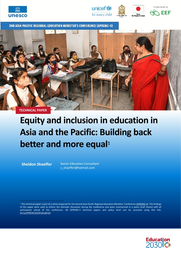Technical paper: Equity and inclusion in education in Asia and the Pacific: Building back better and more equal
The Sustainable Development Goal (SDG) 4 aims to ensure “inclusive and equitable quality education”, and the Asia-Pacific region has made significant progress in increasing both access to, and the quality of, education. However, at the mid-point to the 2030 SDG deadline, there is a “learning crisis”, where millions of learners have failed to learn what they need to learn in order to reach their full potential. At the same time, SDG target 4.5 aims to “eliminate gender disparities in education and ensure equal access to all levels of education for the vulnerable.” Given the learning crisis, exacerbated by COVID-19, achieving this target has become even more challenge, requiring both learning recovery and the transformation of education systems.
The technical paper, “Equity and inclusion in education in Asia Pacific: Building back better and more equal” addresses how the learning crisis has become more sever as a result of COVID-19, especially for the most vulnerable learners who were excluded before the pandemic and face increased vulnerability, exclusion, and greater learning loss after the pandemic. Specific factors excluding the most vulnerable discussed in the paper include gender, poverty, delays and disabilities, location, refugee/migrant status, and language of instruction.
This technical paper is part of a series prepared for the Second Asia-Pacific Regional Education Ministers’ Conference (APREMC-II). The findings of this paper were used to inform the thematic discussion during the conference and were summarized in a policy brief shared with all participants ahead of the conference.
You can find the policy brief here.
To learn more about the conference and other downloadable materials, click here.








